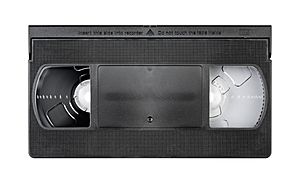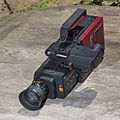JVC facts for kids
 |
|
| Subsidiary | |
| Industry | Professional electronics and consumer goods |
| Founded | September 13, 1927 Yokohama, Japan |
| Headquarters | Yokohama, Japan |
|
Key people
|
Shoichiro Eguchi, President |
| Products | Audio, visual, computer-related electronics and software, media products |
| Revenue | |
|
Number of employees
|
19,044 (Consolidated, as of March 31, 2008) |
| Parent | JVC Kenwood Corp. |
| Subsidiaries | Victor Entertainment JCVision |
JVC is a famous Japanese company. Its full name is Victor Company of Japan, Ltd. It is also known as The Japan Victor Company. JVC makes many kinds of electronics for homes and for professionals. The company is based in Yokohama, Japan.
JVC was started in 1927. It is well-known for two big things. JVC made Japan's first televisions. They also created the Video Home System (VHS) video recorder.
From 1953 to 2008, another big company, Matsushita Electric Industrial Co., Ltd., owned most of JVC. In 2008, JVC joined with Kenwood Corporation. Together, they formed a new company called JVC Kenwood Holdings.
Contents
JVC's Journey: A History of Innovation
JVC began in 1927. Its first name was "The Victor Talking Machine Company of Japan, Limited." In the 1930s, JVC made phonographs and music records.
In 1932, JVC started making radios. Then, in 1939, they made Japan's first TV set. This TV was built right there in Japan. Today, the part of the company that makes music is called Victor Entertainment.
Cool Gadgets from the 1970s
In 1970, JVC released a unique TV called the Videosphere. It was a portable TV shaped like a space helmet. It even had an alarm clock at the bottom. This cool design made it very popular.
In 1971, JVC created a new way to play quadraphonic sound on vinyl records. This system made music sound like it was coming from four different directions.
In 1975, JVC made the first portable radio with a built-in TV. It was called the model 3050. The TV screen was small, about 3-inch (7.6 cm), and showed black-and-white pictures.
One year later, JVC added a cassette recorder to this model. They called it the 3060. This created the world's first boombox that had a radio, a cassette player, and a TV all in one!
Introducing the VHS Recorder
In 1976, JVC showed the very first VCR that used the VHS format. It was called the Victor HR-3300. The president of JVC introduced it on September 9, 1976.
JVC started selling the HR-3300 in Akihabara, Tokyo, Japan, on October 31, 1976. Later, special versions were sold in other countries. For example, the HR-3300U was for the United States. The HR-3300EK was for the United Kingdom.
The Great Video Format War: VHS vs. Betamax
In the late 1970s, JVC created the VHS format. They sold the first VHS recorders to people in 1976. They cost about $1060 US dollars.
Sony had already released their own video tape system called Betamax a year earlier. This started a big competition between JVC's VHS and Sony's Betamax. This fight to be the best was called the "videotape format war."
Why VHS Won the Format War
The Betamax cassette was smaller than VHS. It also had slightly better picture quality. However, Betamax could record for less time than VHS.
Both companies worked hard to get other companies to use their format. By 1984, 40 companies were using JVC's VHS format. Only 12 companies were using Betamax.
Sony started making VHS recorders in 1988. After 1993, they stopped making Betamax recorders for the US market. They completely stopped making Betamax recorders in 2002. This meant VHS had won the format war.
Awards and Festivals
In October 2001, JVC received an Emmy Award. This award was for their "outstanding achievement in technological advancement." It recognized their pioneering work in developing camcorders for everyday people.
JVC also sponsors two well-known events. These are the JVC Tokyo Video Festival and the JVC Jazz Festival. These events help more people learn about JVC and its products.
Images for kids
-
Nivico 7TA-4 Transistor Radio
See also
 In Spanish: JVC para niños
In Spanish: JVC para niños

















